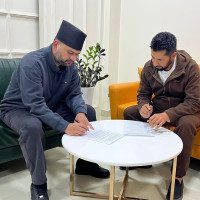Opinion
Forests for life
Deforestation and degradation have resulted in a rapid loss of the world’s forests which provide several ecosystem services along with environmental, social and economic benefits that facilitate human well-being.
Ananta Ram Bhandari
Deforestation and degradation have resulted in a rapid loss of the world’s forests which provide several ecosystem services along withA environmental, social and economic benefits that facilitate human well-being. Restoration of forests is thus critically important to save life on earth. In due course, the concept of Forest Landscape Restoration (FLR) has been brought across deforested and degraded lands to help them regain ecological functions. FLR is about more than just planting trees, it entails restoring a whole landscape to meet present and future needs, allowing multiple benefits and avoiding further degradation of natural forest cover. Plantation, promotion of natural regeneration, enhancement of forest quality and protection of existing forests are the means of Forest Landscape Restoration.
The global context
Nepal is party to global frameworks and partnerships pertaining to Forest Landscape Restoration that aim to catalyse country efforts to achieve national and international commitments that are centred around conservation goals. The Global Partnership on Forest Landscape Restoration (GPFLR) is a proactive global network that unites governments, organisations, academia, communities and individuals to promote an integrated forest landscape restoration approach through which forests, trees and the functions they provide are effectively restored, conserved and employed to help secure sustainable livelihoods and ecological integrity for the future. The Aichi Target 15 focuses on enhancing ecosystem resilience and contribution of biodiversity to carbon stocks through conservation and restoration to contribute to climate change mitigation and adaptation, and combating desertification.
Likewise, the United Nations Global Objectives on Forests, Rio+20 Land Degradation Neutrality Goal and the Sustainable Development Goals build further ground to reverse the loss of forest cover, help achieve a land degradation neutral world in the context of sustainable development, promote sustainable use of terrestrial ecosystems and sustainable management of forests, and stop biodiversity loss.
National reality
Forest restoration initiatives in Nepal started in the late 1970s so as to rehabilitate degraded mid-hills of the country. It is estimated that over 370,000 hectare of plantation forests have been established in the degraded mid-hills of Nepal. As the forest management paradigm shifted to community management approach in the 1970s, local communities protected these plantations and thus the plantation forests have successfully been established. Community forestry is believed to be instrumental in restoring forests and natural ecosystems. So far, over 1.7 million hectares (about 26 percent) of forests have been managed as community forests in the country.
The Forest Landscape Restoration approach was initiated in Nepal after the establishment of Tarai Arc Landscape in 2004. Within this landscape approach, critical corridors and bottlenecks have been identified and initiatives have been implemented to restore forests and maintain the ecosystem’s functionality. Restoration initiatives have been made in all five landscapes of Nepal including Tarai Arc Landscape, Sacred Himalayan Landscape, Chitwan Annapurna Landscape, Kangchenjunga Landscape and Kailash Sacred Landscape. Ministry of Forests and Soil Conservation has been implementing ‘corridor and bottleneck restoration project’ in partnership with WWF-Nepal in Tarai Arc Landscape to restore degraded areas and maintain ecosystem connectivity.
Nepal’s forests today make up 44.74 percent of the total 141,718 sq km area of the Himalayan country, compared to the total forest cover of 39.6 percent recorded in 1998. Nepal’s forest cover has, in effect, increased by five percent. Successful forest restoration and protection programmes, including the country’s far-reaching community forestry programme, are the primary reasons behind this.
Much is being done to guide and achieve the FLR targets, nationally and internationally. However, systematic engagement of multi-stakeholders including government, non-governmental organisations, civil society, local communities and private sector is fundamental in meeting these targets in a timely manner.
Bhandari is the lead of the forest program at WWF Nepal




 12.12°C Kathmandu
12.12°C Kathmandu









%20(1).jpg&w=300&height=200)

